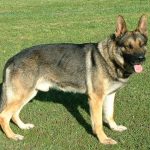The Australian Shepherd Beagle is a charming and unique mix. Physical traits and temperament will depend on the dominant parental race. Below you will find all the information you need on this fascinating dog mix.
What is the Australian Shepherd Beagle mix?
Contents
In a mixed breed, each puppy will be different in terms of its appearance and character. They can also inherit health problems that are specific to the parent breeds.
The Australian Shepherd Beagle mix is a cross between dogs with totally different personalities. They are active dogs and need to work. Also, they are intelligent dogs and can learn very quickly.
Australian Shepherds Beagles are cheerful and tend to get along well with other pets and with children.
Some facts about the Australian Shepherd Beagle mix

The training of this mix will depend on each parent, but they are easy to train in general. In terms of their size, they can vary and depend on the dominant parental breed, but in general, they can measure between 13 and 23 inches, and their weight can be 20 to 65 pounds.
They are healthy dogs and can have a lifespan of 16 years. They usually come in a wide range of colors due to the influence of Australian parents. You can find an Australian Shepherd Beagle with a black, white, and caramel-colored blackbird coat.
Temperament
In temperaments, both Australian Shepherds and Beagles are common dogs. They are intelligent dogs that enjoy being around humans. They are loyal, brave, and family-oriented; they can have a strong prey drive.
Health problems
You must have all the information about its parents when you buy a mixed breed dog. There are pure breeds that usually have certain genetic conditions, and crosses can inherit them. There are some health problems that beagles can suffer, such as:
- Diabetes
- Obesity
- Back problems
- Eye problems
- Hemophilia
- Neurological problems
- Liver disorder
- Heart disease
- Cancer
- Cushing’s disease
- Skin allergies
- Hip dysplasia
- Beagle pain syndrome
Common health problems in Australian Shepherds are:
- Epilepsy
- Hip dysplasia
- Sensitivity to multiple drugs
- Eye problems
How to Train the Australian Shepherd Beagle Mix?
An Australian Beagle Shepherd Dog needs 2 hours of training days when they are adults. You can take it for a walk or jog with you so you can do your daily activities in a fun way. The interaction between you and your dog is extremely important to train him correctly and learn the commands.
Also Read: German Shepherd Yorkie Mix
How to care for your Australian Shepherd Beagle mix?

You must socialize him from when they are puppies to get used to being with more people. Training is the only thing that will help your dog overcome her instincts. If your Australian Shepherd Dog Beagle has more traits than its dominant Beagle parent, they may have a hunting instinct. This means that if you smell a squirrel, cat, or another animal, it can chase you.
You should not leave it off a leash when you go out with your dog because it may trail off any scent, or they may escape.
Nutrition
This dog mix does not have a specific diet; you only need to supply high-quality food for dogs. They can also eat a homemade diet that is well balanced and approved by their vet. You should always give it plenty of water to keep it cool.
Exercise needs
They are very active dogs and require a lot of daily exercises to keep them calm. This is a mix for people who have enough time to take them out for a walk and can spend at least an hour outdoors.
Cleanliness
This mix can have a long or short coat depending on the dominant parent. The method you should use for grooming will depend on your physical features. Both the Australian grasses and the Beagle are shedders; this means that the mixture will also lose a large amount, and you will have to brush them once a day.
If your puppy inherits the ears of the beagles, he should have better hygiene. Clean the ears and check them regularly to avoid bacteria and infections.




